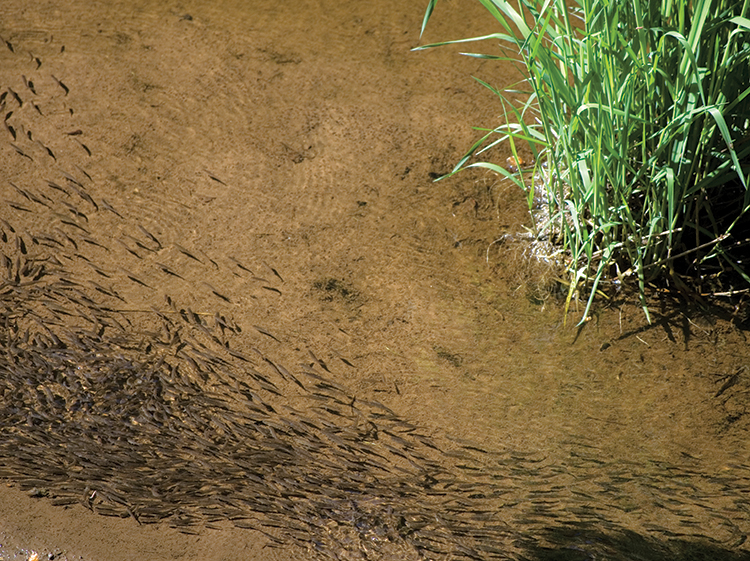Home > Arkansas > Arkansas Crops & Livestock > Arkansas Baitfish Producers Are Hooked for Generations
Arkansas Baitfish Producers Are Hooked for Generations

As a young man, Harry Saul trapped wild minnows in the White River to get by. He built a fish farm to make a life for his family. And now, more than 60 years later, the succeeding generations are hooked on the family business.
Today, the Saul family raises live bait, or minnows, for recreational and sport fishing throughout the Northeast, South and Southeast.
“We are blessed to live on this farm and be able to raise our children on a farm where they can learn a work ethic and see where food comes from,” says Margie Saul, co-owner of Harry Saul Minnow Farm Inc. with husband, James. Their son, William, works in the business, too. Their grandchildren now grow up in it.
The surviving generations reflect on how their late father and grandfather sacrificed to start the farm with 10 acres and a couple of ponds. Today, the family manages about 1,100 acres of land underwater, which includes around 100 ponds. The Sauls employ an average of 15 employees, depending on the season.
And no one is immune to work. To comply with the strict laws at state borders, Margie Saul, an Arkansas Agriculture Board member, learned to drive an 18-wheeler to help haul nearly a half million pounds of baitfish annually to wholesalers and distributors in 17 states.
![baitfish arkansas [INFOGRAPHIC]](https://eadn-wc01-4177395.nxedge.io/wp-content/uploads/2020/06/Screen-Shot-2016-01-21-at-3.55.04-PM.jpg)
Arkansas Takes The Bait
Arkansas farms produce more than 90 percent of baitfish in the United States, estimates Dr. Eric Park, president of the Arkansas Bait and Ornamental Fish Growers Association. Farmers breed, hatch and raise about 6 billion baitfish annually, with an economic impact between $300 million and $350 million, he says.
“Most people have no clue that the Arkansas baitfish industry even exists, and we have been here for 65 years,” Park says.
Harry Saul Minnow Farm sits nestled in the hills and hollows near White River, about 50 miles east of Little Rock. A Google map clearly defines the family’s patchwork quilt of ponds and levies. Their land’s resources, not desirable for row-crop farming, work well as a fish farm, Margie Saul says. In fact, the unique terrain allows gravity to feed water from upper to lower elevation ponds. Then they filter the water and reuse it.

Over time, the Sauls have invested in better harvest sumps, improved water use capabilities and enhanced loading facilities to improve baitfish quality. Back in 2000, the family built a new facility on the farm with improved aeration, liquid oxygen, an ice house, bigger vat system and office, all under one roof.
The Sauls raise golden shiner, black tuffy and red tuffy baitfish. With birds literally eating their profits, a few years ago, the Sauls built hunting pits and allow duck hunting for a fee. The move saves fish and generates some income in an industry with nearly 20 years of stagnant baitfish prices.
“It’s a challenge,” Saul says. “It is not nearly as profitable as it was 30 years ago.”
![arkansas baitfish [INFOGRAPHIC]](https://eadn-wc01-4177395.nxedge.io/wp-content/uploads/2020/06/Screen-Shot-2016-01-21-at-3.55.13-PM.jpg)
Certification Deters Disease Demise of Industry
About 15 years ago, Arkansas’ major baitfish farms, including the Saul family farm, voluntarily adopted the Arkansas Baitfish Certification Program to guarantee a high-quality, safe and bio-secure product, Park says. Baitfish farms voluntarily submit themselves to federal and state inspections twice annually.
“We want the public and our customers to be assured that if you are using our product, there is no chance of introducing an aquatic disease,” Park says.
The program’s stringent qualifications take two years to meet. The initiative helps protect the state’s baitfish industry, which the federal government could potentially shut down with a dangerous disease outbreak, he says. Undoubtedly, healthy, disease-free fish prove important to the future of Harry Saul Minnow Farm Inc. and its next generation.



